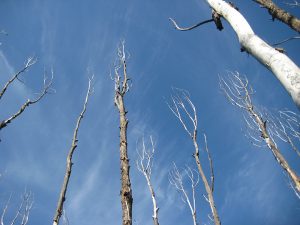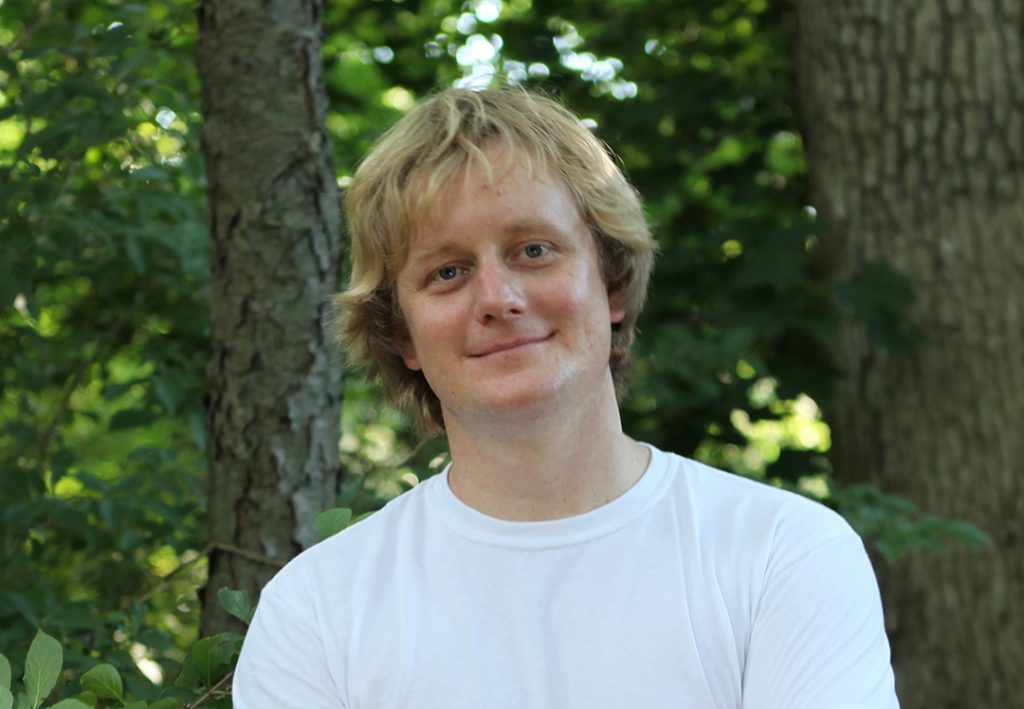[bs_lead]Bill Anderegg, assistant professor in Biology and director of the Anderegg Lab, is a GCSC faculty affiliate conducting research related to ecological and environmental change. [/bs_lead]Read on to learn about his work researching drought recovery and forest die-off, his role in a recently awarded NSF Dynamics of Coupled Natural and Human Systems grant, and how he connects people to his research.
Welcome to campus! What brought you to the U?
I was hired as an eco-hydrologist in the interdisciplinary Society, Water, and Climate faculty group. I’m from Colorado and I really wanted to end up in the West, and I had established prior collaborations with people in the Biology department. When I came for a visit and got the job offer, I was thrilled to join the faculty here. I started in 2016, so I have been here for a little over a year.
What drew you to become a GCSC faculty affiliate?
I was really drawn to the GCSC when I interviewed here because I loved the idea of an interdisciplinary umbrella where everyone interested in the environment, sustainability and global change can connect and interact. Brian Codding [associate professor in Anthropology] and I recently co-led a successful grant proposal for NSF Dynamics of Coupled Natural and Human Systems. The GCSC is the sort of thing that makes the collaboration with Brian possible. Getting to meet and sit down with anthropologists, political scientists or geographers, climate scientists, and humanities folks is not very common in other colleges and universities. I found having the GCSC as a meeting point super exciting, so I applied to join basically right when I got here.
Your research relates to global patterns in drought recovery and forest die-off. How did you become interested in these areas?
I knew I wanted to study climate change coming out of my undergraduate work, but I didn’t know where, what species or what aspects. It was really coming back to a lot of areas where I had grown up camping in Colorado that started my path towards forests and drought in the West.[bs_lead]A ton of these forests I had grown up camping in had died off between when I was a kid and when I came back as a PhD student. This was a very visible and visceral change in my lifetime that started the ball rolling. I wondered, ‘What’s going on here? Is climate change part of the story? How is this occurring, and can we predict it in the future?’[/bs_lead]
It sounds as though your research interest is driven by your own experience – perhaps even your grief – at losing something that had been really important to you.
Yes. Growing up in Colorado I felt like I got to spend a ton of time outside in the forests of the West, especially in the mountain forests. Seeing them change in front of my eyes was both an emotional and intellectual trigger to focus on climate change. So, my PhD work ended up being about what was killing the aspen trees, and trying to predict that into the future.
How do you think that line of research is going to evolve now that you’re here in this ecosystem?
 We’re [Anderegg Lab Group] continuing to work on a number of different western U.S. forests. Some of those will be the mountain forests, like the aspen forests in Colorado. But we’ve also got a lot of new projects starting up and one of those will be the juniper woodlands in southern Utah. This is part of the new NSF grant mentioned earlier. I will investigate similar questions to my prior research, but fundamentally tied in with the human systems that depend on the forests as well.
We’re [Anderegg Lab Group] continuing to work on a number of different western U.S. forests. Some of those will be the mountain forests, like the aspen forests in Colorado. But we’ve also got a lot of new projects starting up and one of those will be the juniper woodlands in southern Utah. This is part of the new NSF grant mentioned earlier. I will investigate similar questions to my prior research, but fundamentally tied in with the human systems that depend on the forests as well.
Can you say more about what you mean by “the human systems that depend on the forests”?
The best estimate is that eighty percent of homes on the Navajo Nation are heated exclusively on firewood from pinyon and juniper trees throughout the winter. There’s a large traditional livelihood in collecting firewood in the fall before the winter. The fundamental question is how sustainable this will be in a changing climate. We know that in some areas juniper might expand. But the projected hotter and drier summers, along with less snow in the southwest are probably going to be hard on trees – we’ve already seen a large pinyon die-off happen. In this grant, we want to know if the supply of firewood will increase or decline in the future. Will harvesting demand increase or decline? (We will also largely have warmer winters, so maybe people will need slightly less firewood). What’s the potential for alternative fuel sources and heating homes through other fuels and technologies? These questions are all within the scope of the grant.
What role will you and your lab play in answering these questions?
Our goal is to use the physiology of how trees respond to different environments to predict the health of these forests thirty, fifty, and one hundred years in the future. We’ll do that by measuring trees throughout Utah and also looking at the rings the trees build to go back in time to see how they’ve responded to climate in the past, then building mathematical tools to predict what different regions and different species should be doing in the future. In different climates and scenarios, one of the key uncertainties is what society decides to do about climate change – that’s kind of the fundamental unknown.
When you say “the physiology of trees,” you’re talking about their water uptake, right?
Drought is one of the biggest things we’re worried about in the West and we know from all sorts of paleoclimate research that there have been mega droughts in the past –two to three decade droughts that we could also conceivably see in the future. So, we focus a lot on the water relations of trees and how they take up water when they’re stressed, and how vulnerable or resilient they are to droughts.
It seems that a critical topic in doing research alongside indigenous communities relates to who tells stories and the impacts of publicizing this research on people. For example, Brian Codding discusses the ethics of publicizing Native firewood collecting patterns, because mapping these collection locations could put communities at risk if their wood is taken from contested land. How are you and the other researchers navigating this terrain?
It’s a good question and I think we’ve got a lot to learn and discuss about that. My take on it is that this is only a success if this is a partnership with these native communities and a dialogue, and it’s not the researchers coming in and saying ‘we’re going to tell this story and study these things and publish them to the world.’ It will be a larger success if this is a team effort where we learn a ton from the folks doing the harvesting, and they can learn from what we find as well. We are working closely with the Utah Diné Bikéyah, a nonprofit group that supports indigenous communities in protecting their culturally significant, ancestral lands. We’re planning to have frequent meetings where the dialogues and conversations related to our research questions are happening, and listen to what they know already.
On the note of stories, what are some of the tools that you find important for communicating your research?
I think it’s compelling to tell stories, especially to make the stories relatable, concrete and local. Climate change impacts on forests in the West really tells a story. You can drive up the highway here and see dead spruces where the spruce beetles are moving through, and you can drive down to southern Utah and see where all the dead pinyons are. In Colorado for the last decade or two, you basically could not drive on any mountain pass and not see dead hillsides and dead pine trees from the mountain pine beetle. Everyone knows it’s happening because it’s hard to miss on the landscape. There’s a lot of science behind linking climate change to these changes. So that’s some of what I try to do when talking to audiences.
Is there anything I haven’t asked you that you think the readers should know?
One thing that we’re starting to work on is the effects of climate change on hunting and angling in the U.S. We are connecting with sportsmen and women on how climate change is likely to affect them, and reaching out beyond traditional audiences that we speak to as scientists. It’s somewhat of a side project at the moment, but thinking about how to be creative and build a broader environmental tent of more folks who care about climate change is something that I’m quite excited about.

